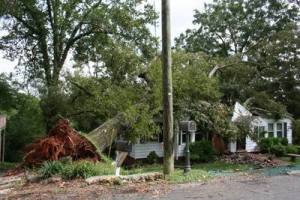The weather report suggests that we might see some sunshine over the long weekend. Wow-wee, long time coming! It will be a blessing to feel some sun on our faces, but I know that the sunshine will also mean something else – yard work. Ah, I can hear the drone of lawnmowers already.
Before you push the lawn mower out of the shed though, take a look at your lawn. With all this rain, I imagine it is pretty green and lush. If you take a closer look though, do you see any tree roots creeping amongst the blades of grass? Have you tripped over roots while walking along or bumped into them with the lawn mower? CLC Tree Services hears these complaints on a weekly basis. The most frequent questions we get are;
“Can we cut the tree roots out?“
“Is topdressing the roots a good solution, so they are no longer exposed?“.
While both of these solutions might seem like viable answers, neither is a great cure for your root problems.
CUTTING TREE ROOTS OUT OF YOUR LAWN
Trees are living entities that require several things to remain healthy. One of those requirements is nutrition. Trees receive their nutrition via their roots, where they absorb nutrients to send to the rest of the tree.
When you remove roots, you effectively diminish the tree’s available food sources. This can lead to disease and/or a distressed tree, if too many roots are cut. While removing a few roots may not be overly detrimental to the overall health of the tree, cutting in appropriate locations and having the knowledge of the health of the remaining roots is key before putting your tree into a stressed situation. Trees will regrow their root systems, but it is a slow process. It is always best to consult with a certified arborist before taking aim at removing tree roots.
Another thing to keep in mind before cutting out offending roots, is the overall stability of the tree. A tree’s roots act as an anchor. If too many roots are removed, or the remaining roots are rotten or diseased, you may be in danger of having the tree topple by cutting out its supporting root system. While those bumps in the lawn might bother you, wouldn’t a tree nestled onto the roof of your house be far worse? Without adequate tree root support, your tree has nothing to support itself with when a stiff wind blows.

Without adequate tree roots, your tree won’t have the support it needs to support itself in high winds
TOPDRESSING TREE ROOTS
Topdressing might seem like a great idea, but before you heap on the dirt, think about what the function of tree roots are before you cover them up. Roots absorb water and nutrients, but they also intake oxygen. If you pile on dirt to cover up exposed roots, you deprive those roots of the air they need to function and live. You might not realize it, but this harms the whole tree. All for the sake of aesthetic repairs.
A little soil is one thing, but even a few inches might choke the roots. You might not notice it at first, but the tree will. Before long, you might notice that limbs at the crown of the tree begin to die off. This is because the tree is working harder to distribute oxygen and nutrients to its limbs. Hence, the further away from the root system, the less likely those vital nutrients will reach the outer parts of the tree.
If you do want to apply some soil around tree roots, make sure it has plenty of organic matter in it to limit the soil compaction that may occur. Soil compaction works in much the same way as too much dirt—tree roots cannot breathe. In fact, soil compaction also affects the root’s ability to intake water. If you suspect that your soil is compacted around the base of your trees due to machinery, foot traffic or whatever other reason, consider getting your lawn aerated. It helps your lawn as well as your beautiful trees.

Piling dirt on top of tree roots creates compaction, prevents the roots from getting enough oxygen, and prevents adequate water absorption.
If you find that your lawn has a spider web of roots scattered across it and are not sure what to do, drop CLC Tree Services a line. We can offer you advice, or come out to inspect your tree and get to the root of the problem. We hope you have a fabulous Victoria Day long weekend!


You must be logged in to post a comment.